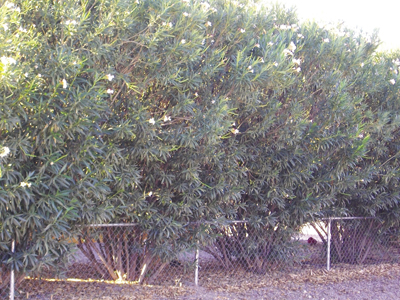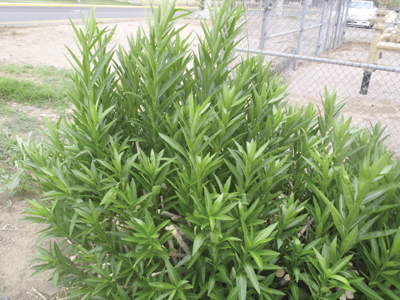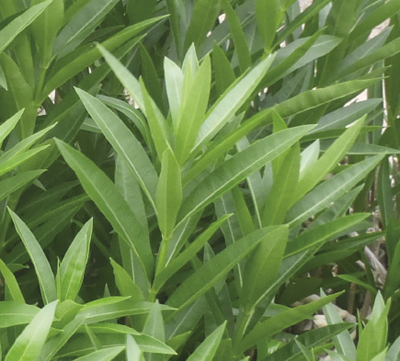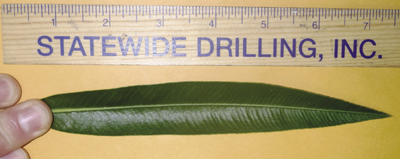Oleander Poisoning of Horses
Guide B-712
Revised by Jason L. Turner.
College of Agricultural, Consumer and Environmental Science, New Mexico State University
Author: Professor and Extension Horse Specialist, Department of Extension Animal Sciences and Natural Resources. (Print-Friendly PDF)
Introduction
The oleander plant (Nerium oleander; Photo 1) is a native plant of the Mediterranean region and tropical Asia. It is now widely planted as a drought-tolerant ornamental in the southern United States and Mexico. It is well suited to poor soil conditions and thrives in full sunlight. It is commonly used in roadside plantings, hedges, and yard landscapes. While oleander has value as an ornamental, it is important that people—and especially animal owners—are aware of the toxicity problems associated with the plant. Renier et al. (2013) reported that poisoning cases in horses were often associated with changes in ownership or stable environment (change in location or an animal escaping a stable to access oleander) as well as the performance of landscape maintenance.

Photo 1. White oleander trees in a hedge. (Courtesy of Jason Turner.)
Description of Plants
Oleander can grow as a single or multi-branched evergreen tree or shrub, reaching heights of 10 to 18 feet with a spread of 10 to 15 feet (Photo 2). The simple leaves are opposite or arranged in whorls and have an oblong or lanceolate shape varying from 4 to 8 inches long. The bottom side of the leaf is pale green, while the top has a glossy dark green color (Photo 3). The leathery texture and veins arranged in opposing pairs are further identifying characteristics of the leaves (Photo 4). The 5-petal, funnel-shaped flowers are various shades of red, white, pink, yellow, orange, or purple and have a pleasant fragrance.

Photo 2. Oleander shrub. (Courtesy of Jason Turner.)

Photo 3. Contrasting colors of leaf sides. (Courtesy of Jason Turner.)

Photo 4. Close-up of leaf showing leaf shape and veins arranged in opposing pairs. (Courtesy of Jason Turner.)
Toxic Principles
Oleander poses a problem for animal owners because it contains cardiotoxic compounds known to poison animals, including humans, dogs, cats, horses, cattle, sheep, goats, llamas, and birds. The primary toxic agent, oleandrin, causes heart arrhythmias that lead to cardiac arrest and death. Although the toxins are found throughout the entire plant, animal poisonings are typically due to ingestion of the leaves. In horses, as little as 1 ounce of green leaves can be lethal. While horses rarely eat green oleander leaves since they are unpalatable, there is the potential for dried leaves to accumulate in pasture areas with tall grass or end up in the horse’s daily hay ration, where they may then be ingested. The toxic compounds are retained in the dried plant leaves, although in reduced quantities, where they can still cause death.
Symptoms
Horses that consume a lethal dose of oleander leaves are often found dead 8 to 10 hours later, and symptoms of poisoning rarely last more than 24 hours before death occurs. Clinical symptoms include colic, diarrhea, labored breathing, muscle tremors, ataxia, and the inability to stand. Furthermore, an irregular and weak pulse, due to the decreased cardiac output, will lead to cold extremities, and convulsions prior to death are not uncommon.
If you suspect that your horse may be suffering from these symptoms of oleander poisoning, it is extremely important to contact your veterinarian immediately. While there is no specific treatment for counteracting the effects of the toxic principles, animals that have not consumed a lethal dose may be treated with a guarded prognosis for recovery over the next several days. A retrospective study of 27 cases of oleander poisoning of horses admitted to a university veterinary teaching hospital for treatment reported that 15 horses survived and were discharged from the hospital (Renier et al., 2013).
Management: Prevention and Control Measures
As is the case with most plant poisoning issues, prevention is the best medicine. Therefore, be diligent in keeping an eye out for oleander leaves on your horse property and remove any plants you find to keep your horse safe. Because all parts of the plant are toxic, it is recommended that those handling oleander wear gloves and dispose of the bagged plant material in a landfill. Burning the material is not recommended since the toxic compounds are released in the smoke and may cause poisoning or other health hazards to those nearby. Remember that this plant is toxic to various animals, including humans.
References
Knight, A.P. 2010. Nerium oleander. In A. Knight (Ed.), Guide to Poisonous House and Garden Plants. Retrieved May 4, 2023, from https://www.ivis.org/library/guide-to-poisonous-house-and-garden-plants
Hart, C.R., T. Garland, A.C. Barr, B.B. Carpenter, and J.C. Reagor. 2003. Toxic plants of Texas [B-6105]. Bryan: Texas Cooperative Extension Service.
Burrows, G.E., and R.J. Tyrl. 2001. Toxic plants of North America. Ames: Iowa State University Press.
Renier, A.C., P.H. Kass, K.G. Magdesian, J.E. Madigan, M. Aleman, and N. Pusterla. 2013. Oleander toxicosis in equids: 30 cases (1995–2010). J Am Vet Med Assoc, 242:540–549. https://doi.org/10.2460/javma.
For further reading
B-709: Milkweed Poisoning of Horses
https://pubs.nmsu.edu/_b/B709/
B-710: Russian Knapweed and Yellow Star-thistle Poisoning of Horses
https://pubs.nmsu.edu/_b/B710/
B-713: Locoweed Poisoning of Horses
https://pubs.nmsu.edu/_b/B713/
Original authors: Jason L. Turner, Extension Horse Specialist; Patrick Torres, Northern District Extension Director, Santa Fe County Extension Office, both of New Mexico State University.

Jason L. Turner is a Professor and Extension Horse Specialist at NMSU. He was active in 4-H and FFA while growing up in Northeastern Oklahoma. His M.S. and Ph.D. studies concentrated on equine reproduction, health, and management. His Extension programs focus on proper care and management of the horse for youth and adults.
To find more resources for your business, home, or family, visit the College of Agricultural, Consumer and Environmental Sciences on the World Wide Web at aces.nmsu.edu/pubs
Contents of publications may be freely reproduced for educational purposes. All other rights reserved. For permission to use publications for other purposes, contact pubs@nmsu.edu or the authors listed on the publication.
New Mexico State University is an equal opportunity/affirmative action employer and educator. NMSU and the U.S. Department of Agriculture cooperating.
Revised October 2023 Las Cruces, NM


